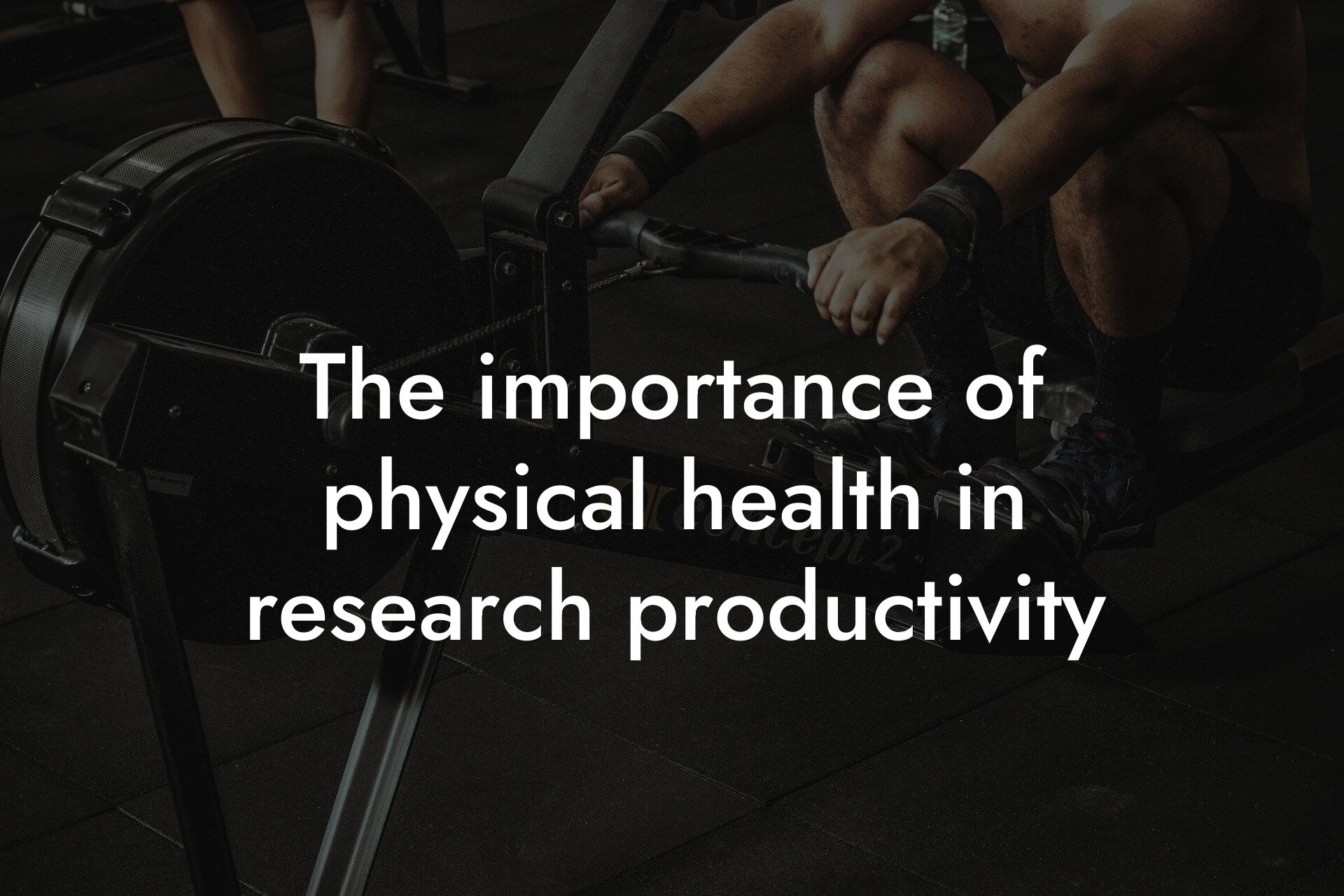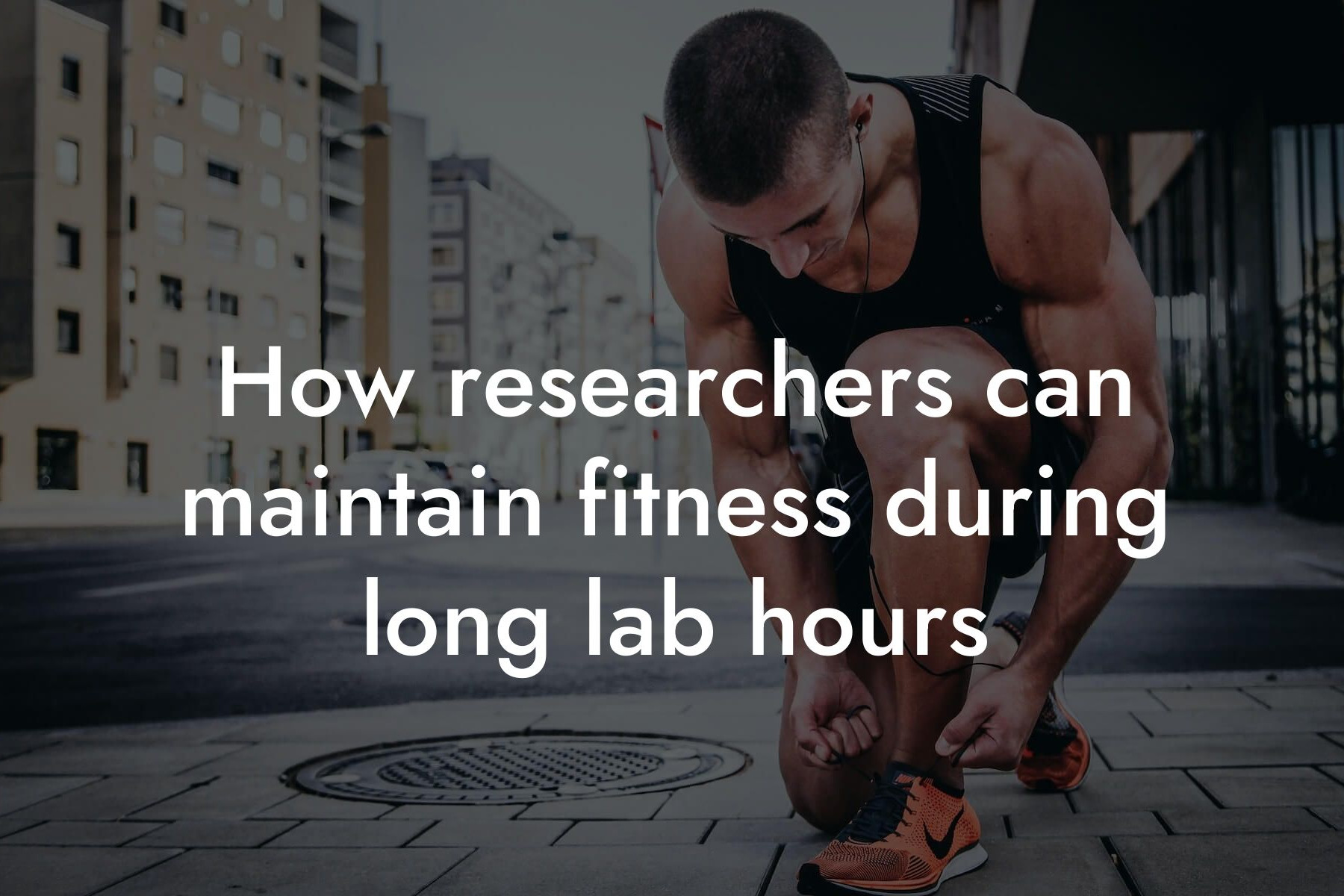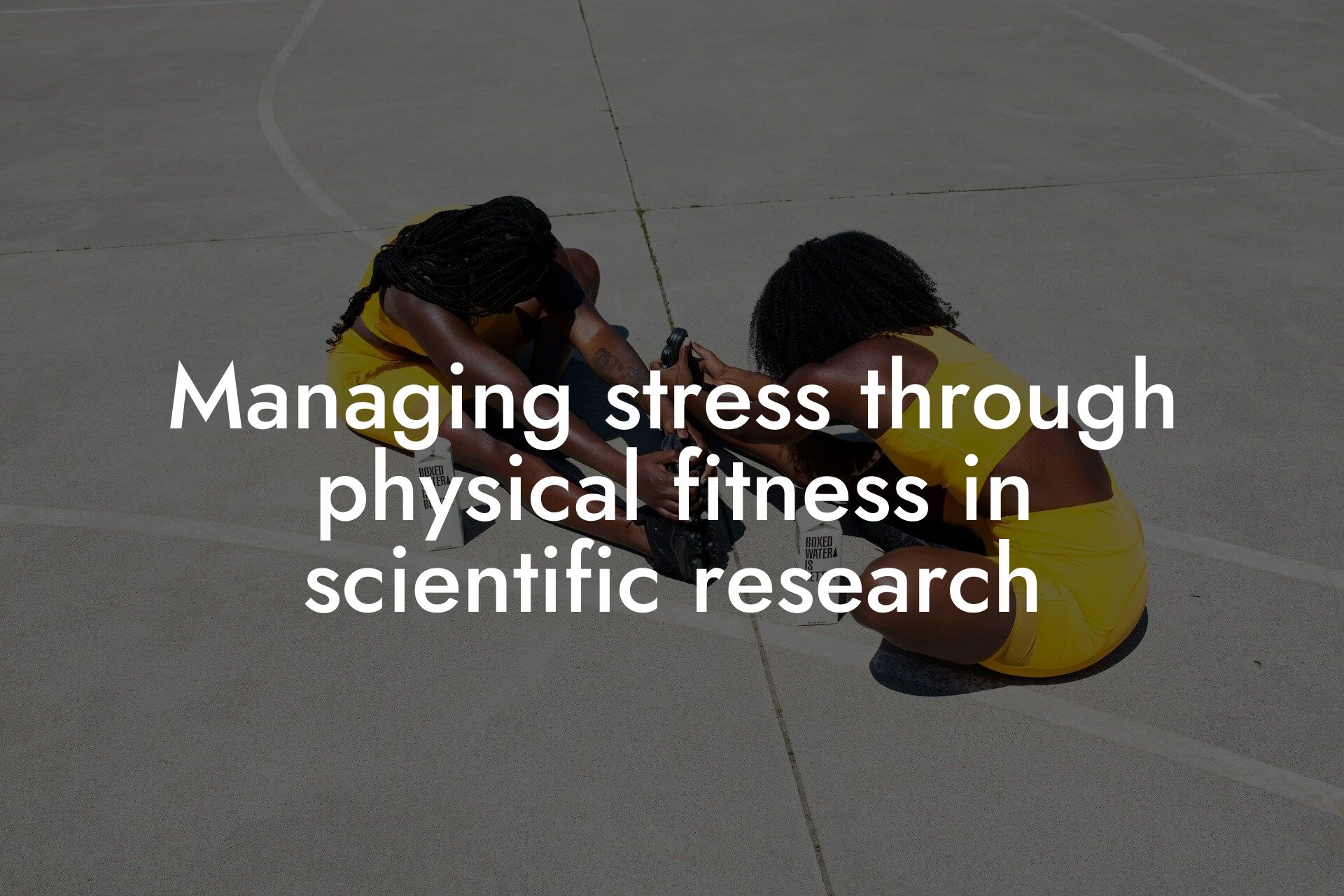As a researcher, you know how demanding your job can be. Long hours in the lab, staring at petri dishes, and pouring over data can take a toll on your physical and mental health. But, what if you could squeeze in a quick workout during your lab breaks to boost your energy, productivity, and overall well-being? In this article, we'll show you how to fit in a quick and effective workout during your lab breaks, even with a busy schedule.
Table of Contents
Why Exercise is Crucial for Researchers
Exercise is essential for everyone, but it's particularly important for researchers who spend most of their time sitting or standing in one place. Prolonged periods of inactivity can lead to a range of health problems, including obesity, diabetes, and cardiovascular disease. Regular exercise, on the other hand, can help improve cognitive function, reduce stress, and increase productivity.
As a researcher, you know how important it is to stay focused and alert during long experiments or data analysis sessions. Exercise can help improve your concentration and mental clarity, allowing you to stay on top of your game even during the most challenging tasks.
Benefits of Quick Workouts During Lab Breaks
Fitting in a quick workout during your lab breaks can have numerous benefits, including:
• Improved cardiovascular health: Regular exercise can help lower blood pressure, improve circulation, and reduce the risk of heart disease.
• Increased energy levels: Exercise can help boost your energy levels, reducing fatigue and improving your overall mood.
• Enhanced cognitive function: Exercise has been shown to improve memory, concentration, and problem-solving skills, making you a more effective researcher.
• Better time management: By incorporating exercise into your lab breaks, you can learn to manage your time more effectively, prioritizing tasks and staying focused on your goals.
Choosing the Right Exercises
When it comes to quick workouts during lab breaks, you don't need to worry about elaborate equipment or hour-long sessions. Instead, focus on exercises that are easy to do, require minimal equipment, and can be completed in 10-15 minutes. Some great options include:
• Bodyweight exercises: Squats, lunges, push-ups, and planks are all great exercises that can be done without any equipment.
• Resistance band exercises: Resistance bands are lightweight, portable, and can be used to work out your entire body.
• Yoga or stretching: Yoga and stretching exercises can help improve flexibility, reduce stress, and increase energy levels.
Sample Workout Routine
Here's a sample workout routine you can follow during your lab breaks:
• Warm-up: 2-3 minutes of light cardio, such as jumping jacks or jogging in place
• Squats: 3 sets of 10 reps
• Push-ups: 3 sets of 10 reps
• Lunges: 3 sets of 10 reps (per leg)
• Plank: 3 sets of 30-second hold
• Cool-down: 2-3 minutes of stretching
Tips for Fitting in a Quick Workout
Fitting in a quick workout during your lab breaks requires some planning and creativity. Here are some tips to help you get started:
• Schedule it in: Treat your workout as a non-negotiable part of your lab break routine.
• Find a quiet space: Look for a quiet corner or room in the lab where you can exercise without distractions.
• Keep it simple: Focus on exercises that are easy to do and require minimal equipment.
• Make it a habit: Try to exercise during every lab break to make it a habit.
Overcoming Common Obstacles
We know that fitting in a quick workout during your lab breaks can be challenging, especially when you're faced with tight deadlines and demanding experiments. Here are some common obstacles you may face and how to overcome them:
• Lack of time: Break your workout into smaller chunks, such as 5-10 minutes, to fit it into your busy schedule.
• Fatigue: Start with low-intensity exercises and gradually increase the intensity as you build up your energy levels.
• Distractions: Find a quiet space or use noise-cancelling headphones to minimize distractions.
Tracking Your Progress
Tracking your progress is essential to staying motivated and seeing the results of your quick workouts. Here are some ways to track your progress:
• Wearable fitness trackers: Use a fitness tracker to monitor your heart rate, steps taken, and calories burned.
• Mobile apps: Download mobile apps that allow you to track your workouts, set reminders, and monitor your progress.
• Journaling: Keep a workout journal to track your exercises, sets, reps, and progress over time.
Fitting in a quick workout during your lab breaks can have a significant impact on your physical and mental health. By choosing the right exercises, scheduling it in, and overcoming common obstacles, you can improve your overall well-being and become a more productive and effective researcher.
Remember, every small step counts, and even a 10-minute workout can make a big difference. So, take the first step today and start incorporating quick workouts into your lab breaks. Your body – and your research – will thank you!
Frequently Asked Questions
What inspired Tano Performance Group to create quick workouts for researchers during lab breaks?
At Tano Performance Group, we understand the demands of being a high-earning professional and the importance of maintaining a healthy physique. We recognized that researchers, in particular, often have limited time for exercise due to their demanding schedules. Therefore, we created quick workouts specifically designed for researchers to fit into their lab breaks, helping them prioritize their physical health without compromising their work.
How can I fit a workout into my already busy lab schedule?
We understand that time is a precious commodity for researchers. Our quick workouts are designed to be completed in 10-15 minutes, making it easy to fit them into your lab breaks. You can even break them down into shorter sessions if needed. Remember, every bit counts, and consistency is key.
Do I need any special equipment or gear for these workouts?
Not at all! Our workouts are designed to be equipment-free, using your own body weight as resistance. This means you can do them anywhere, anytime, without worrying about finding a gym or lugging around equipment.
What if I'm not very fit or haven't exercised in a while?
Don't worry! Our workouts are designed to be low-impact and adaptable to your fitness level. We provide modifications and alternatives to ensure you can participate safely and comfortably. If you have any concerns, consult with a healthcare professional before starting any new exercise routine.
Will these workouts interfere with my focus or productivity during lab work?
Actually, the opposite is true! Exercise has been shown to improve cognitive function, boost energy levels, and enhance focus. Our quick workouts are designed to give you a mental and physical break, helping you return to your lab work refreshed and revitalized.
Can I do these workouts during other breaks, like lunch or coffee breaks?
Absolutely! While our workouts are specifically designed for lab breaks, you can do them during any break you have throughout the day. The key is to find a consistent time that works for you and stick to it.
How often should I do these quick workouts?
Aim to do our quick workouts 2-3 times a day, depending on your schedule and energy levels. Consistency is key, so try to make them a regular part of your daily routine.
What if I have a desk job and don't have access to a lab?
Our quick workouts are not limited to lab researchers! They can be done by anyone with a desk job or limited space. Simply find a quiet spot, like a conference room or outdoor area, and get moving.
Will these workouts help me lose weight or improve my body composition?
While our quick workouts are not specifically designed for weight loss, they can help improve your overall fitness and body composition. Combine them with a healthy diet and lifestyle, and you may see improvements in your physique over time.
Can I do these workouts with a colleague or friend?
Absolutely! Exercising with a buddy can be a great motivator and help you stay accountable. Grab a colleague or friend and do our quick workouts together during your lab breaks.
What if I have an injury or chronic condition that prevents me from doing certain exercises?
We understand that injuries and chronic conditions can impact your ability to exercise. If you have any concerns, consult with a healthcare professional before starting our quick workouts. They can help you modify exercises or provide alternative options that are safe for you.
Can I customize the workouts to fit my specific fitness goals?
Yes! Our quick workouts are designed to be adaptable to your fitness goals and needs. Feel free to modify exercises, increase or decrease intensity, or add your own exercises to tailor the workouts to your goals.
How can I track my progress and stay motivated?
Use a fitness tracker, journal, or mobile app to track your progress and stay motivated. Celebrate small victories, like increasing your workout frequency or completing a challenging exercise. This will help you stay engaged and motivated to continue.
What if I'm not seeing results or feeling frustrated with the workouts?
Don't get discouraged! It's normal to plateau or feel frustrated with exercise. Take a break, reassess your goals, and try modifying the workouts or adding new exercises to challenge yourself. Remember, consistency and patience are key to seeing results.
Can I do these workouts during pregnancy or postpartum?
Always consult with a healthcare professional before starting any new exercise routine during pregnancy or postpartum. They can help you modify exercises or provide guidance on safe exercises for your stage of pregnancy or postpartum recovery.
What if I have a disability or mobility issue that prevents me from doing certain exercises?
We understand that disabilities and mobility issues can impact your ability to exercise. Consult with a healthcare professional or fitness expert who specializes in adaptive exercise to help you modify exercises or find alternative options that are safe and accessible for you.
Can I use these workouts as a warm-up or cool-down for other exercises?
Absolutely! Our quick workouts can be used as a warm-up or cool-down for other exercises, like yoga or weightlifting. They can help increase blood flow, reduce muscle tension, and prepare your body for more intense exercise.
How can I incorporate stretching or foam rolling into my quick workouts?
Incorporate stretching or foam rolling into your quick workouts by adding 2-3 minutes of stretching or foam rolling at the end of each workout. This can help improve flexibility, reduce muscle soreness, and enhance overall recovery.
What if I'm feeling tired or fatigued during the workouts?
Listen to your body! If you're feeling tired or fatigued, take a break or modify the exercises to make them easier. Remember, it's okay to rest and recover. Pushing yourself too hard can lead to burnout or injury.
Can I use these workouts as a stress-relief technique?
Absolutely! Exercise is a great way to reduce stress and anxiety. Our quick workouts can help you blow off steam, clear your mind, and feel more focused and energized.
How can I make these workouts more challenging or intense?
If you're finding the workouts too easy, try increasing the intensity by adding more reps, sets, or weight. You can also decrease rest time between exercises or add more complex movements to challenge yourself.
What if I have a question or need guidance on a specific exercise?
Reach out to us at Tano Performance Group! We're here to help and provide guidance on any exercise or workout-related questions you may have. Contact us through our website or social media channels.
Can I share these workouts with colleagues or friends?
Absolutely! Share the benefits of our quick workouts with your colleagues or friends. You can even start a workplace fitness challenge or group to help motivate and support each other.
Here are some related articles you might love...
- The importance of physical health in research productivity
- How researchers can maintain fitness during long lab hours
- Managing stress through physical fitness in scientific research
- The impact of body composition on cognitive function in research
- Balancing lab work with personal fitness goals
- Nutrition strategies for maintaining focus during experiments
- The role of physical fitness in preventing research-related injuries
- How to stay active during sedentary research work
- How DEXA scans can benefit scientists and researchers
Zak Faulkner
Zak Faulkner is a leading authority in the realm of physical health and body composition analysis, with over 15 years of experience helping professionals optimise their fitness and well-being. As one the experts behind Tano Performance Group, Zak has dedicated his career to providing in-depth, science-backed insights that empower clients to elevate their physical performance and overall health.
With extensive knowledge of DEXA technology, Zak specializes in delivering comprehensive body assessments that offer precise data on body fat, muscle mass, bone density, and overall physique. His expertise enables individuals to make informed decisions and achieve their fitness goals with accuracy and confidence. Zak’s approach is rooted in a deep understanding of human physiology, combined with a passion for helping clients unlock their full potential through personalised strategies.
Over the years, Zak has earned a reputation for his commitment to excellence, precision, and client-focused service. His guidance is trusted by top professionals who demand the best when it comes to their health. Whether advising on fitness programs, nutritional strategies, or long-term wellness plans, Zak Faulkner’s insights are a valuable resource for anyone serious about taking their health and fitness to the next level.
At Tano Performance Group, Zak continues to lead our Content Team revolutionising how professionals approach their physical health, offering unparalleled expertise that drives real results.




